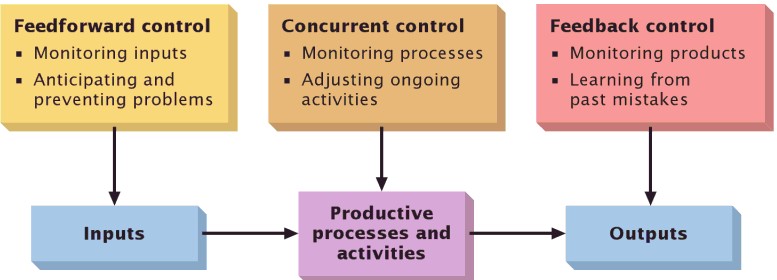Depending on the stages at which control is exercised, it may be of three types: (1) control of inputs that are required in an action, known as feed forward control; (2) control at different stages of action process, known as concurrent, real-time, or steering control; and (3) post action control based on feedback from the completed action, known as feedback control. Control at various stages of action is presented in figure.

Feed Forward Control: Feed forward control involves evolution of inputs and taking corrective action before a particular sequence of operation _completed. Thus, it attempts to remove the limitations of time lag in taking corrective action. Feed forward control monitors inputs into a process determine whether the inputs are as planned. If inputs are not as planned corrective action is taken to adjust the inputs according to the plan so that the desired results are achieved within the planned inputs. To be effective, feed forward control should meet the following requirements:
- Thorough and careful analysis of the planning and control system must be made, and the more important input variables identified.
- A model of the system should be developed.
- The model should be reviewed regularly to see whether the input variables identified and their relationship still represent realities.
- Data on input variables must be regularly collected and put into the system.
- The variations of actual input data from planned inputs must be regularly assessed, and their impact on expected results is evaluated.
- Action must be taken to show people problems and the measure required to solve them
Concurrent Control: Concurrent control is exercised during the operation of a programme. It provides measures for taking corrective action or making adjustments while the programme is still in operation and before any damage is done. In the organisational context, many control activities are based on this type of control, for example, quality control during the operation, or safety check in a factory, here, the focus is on the process itself. Data provided by this control system is used to adjust the process. Many strategic controls fall in this category.
Feedback Control: Feedback control is based on the measurement of the results of an action. Based on this measurement, if any deviation is found between performance standards and actual performance, the corrective action is undertaken. The control aims at future action of the similar nature so that there is conformity between standards and actual. This is required because, sometimes, feed forward or concurrent control is not possible to apply, for example, many personal characteristics of an individual which go into behavioral processes are not measurable, and hence feed forward control is difficult to apply. In the business organizations, top management control is mostly based on feedback. To Intake feedback control effective, it is essential that corrective action is taken as soon-as possible.

